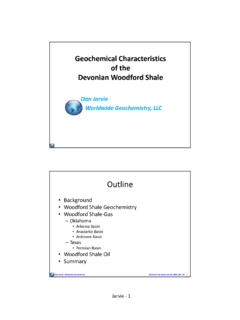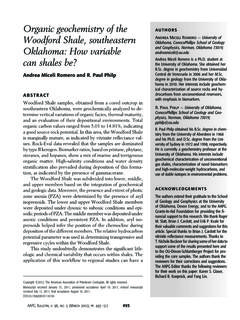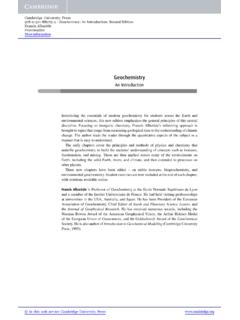Transcription of Environmental Geochemistry
1 UNESCO EOLSSSAMPLE CHAPTERSGEOPHYSICS AND Geochemistry - Environmental Geochemistry - Peggy A. O Day Encyclopedia of Life Support Systems (EOLSS) Environmental Geochemistry Peggy A. O Day Arizona State University, Tempe, AZ, USA Keywords: Environmental Geochemistry , time and space scales, chemical principles, equilibrium thermodynamics. Kinetics and mass transfer, geochemical partitioning, Environmental contaminants, organic compounds, inorganic contaminants, biological contaminants, Environmental change and human impact Contents 1 .Introduction 2. Time and Space Scales 3. Chemical Principles Equilibrium Thermodynamics Kinetics and Mass Transfer 4. Geochemical Partitioning 5 . Environmental Contaminants Organic Compounds Inorganic Contaminants Biological Contaminants 6. Environmental Change and Human Impact Glossary Bibliography Biographical Sketch Summary The surface environment of our planet is the result of approximately Ga of physical, chemical, and biological evolution.
2 Geochemical systems are linked to the biosphere and lithosphere, and interact in a variety of ways and on a variety of scales in both space and time. Geochemical models that attempt to quantitatively describe selected parts of natural systems rely on the fundamental principles of thermodynamics, kinetics, and mass transfer to supply a theoretical framework. Thermodynamics provides a quantitative tool for evaluating whether or not geochemical systems are at equilibrium, and for predicting the potential for chemical reactions. Kinetics is concerned explicitly with the rates at which reactions occur. These principles are used to describe how mass will be transferred from one part of the system to another, or how particular chemical species will be partitioned among solid, aqueous, and gas phases.
3 The behavior of contaminants in the environment, and often their toxicity to humans and organisms, depends on the chemical form, or speciation, of an element. Contaminants are classified as organic, inorganic, or biological, and they disperse in the environment from a variety of anthropogenic and natural sources. The quantitative understanding and prediction of global scale Environmental impacts from anthropogenic activities requires a combination of thermodynamic and kinetic analyses, and extrapolation over a range of space and time scales. UNESCO EOLSSSAMPLE CHAPTERSGEOPHYSICS AND Geochemistry - Environmental Geochemistry - Peggy A. O Day Encyclopedia of Life Support Systems (EOLSS) 1. Introduction Environmental Geochemistry in a broad sense may include any geochemical process that occurs at or near the surface of the Earth, which encompasses an enormous array of chemical reactions and systems.
4 Practically speaking, research in Environmental Geochemistry tends to focus on chemical processes that affect humans and the human environment. These topics may include contaminant chemistry (in water, soil, or air), degradation of natural resources involving chemical changes, and climatic changes. Because of the connectivity of systems on our planet, strictly inorganic chemical reactions cannot be easily isolated from related physical and biological processes. This complexity leads to the need for geochemical models that attempt to simplify and quantify processes within isolated parts of Earth s chemical system. Quantitative model descriptions based thermodynamics and kinetics require knowledge of numerical constants and parameters, and of system composition and boundary conditions, that can be accurately extrapolated over ranges of temperature, pressure, space, and time.
5 This article begins with a brief review of space and time scales, and the thermodynamic and kinetic principles that are used as the fundamental basis to describe geochemical systems relevant to Earth s surface environment. The concepts of geochemical partitioning as it relates to the movement and transformation of chemical species are discussed. This is followed by a brief summary of the important classes of Environmental contaminants and their threat to human and ecosystem health. Topics related to global Environmental change and degradation as a result of anthropogenic activities, and the potential for remediation and reversals in the context of Geochemistry , are briefly discussed. 2. Time and Space Scales The spatial scale of geochemical processes at and near Earth s surface ranges from atomic (1010m ) to global (710 m ).
6 Likewise, the time scale of chemical transformations is very short (less than one second) for phenomena such as making and breaking chemical bonds, or very long (millions of years) if processes such as global climate change are considered (Figure 1). The choice of space and time scales in the analysis of Environmental Geochemistry depends largely on the nature of the system under study. For example, contamination of groundwater by arsenic could be examined at the molecular scale by using spectroscopic methods, to understand the dissolution of arsenic-bearing minerals, and the chemical form of arsenic as it is released into solution. Alternatively, the migration of arsenic in the groundwater system could be examined on a larger space and time scale, to determine its transport, accumulation, and distribution in a large aquifer.
7 A still larger scale would be to consider the global geochemical cycling of arsenic. Geochemical systems are complex because processes and interactions are variable in space and time. While some changes may be unidirectional for a certain space and time scale (for example, global warming), the overall trend may be quite variable when viewed for a different length of space and time (for example, annual climate variations). Observations, measurements, and simulations of geochemical processes lead to the development of geochemical models that attempt to quantify the behavior of systems in UNESCO EOLSSSAMPLE CHAPTERSGEOPHYSICS AND Geochemistry - Environmental Geochemistry - Peggy A. O Day Encyclopedia of Life Support Systems (EOLSS) order to predict future trends or consequences.
8 In accord with the processes they simulate, geochemical models use different physical and chemical foundations tailored to the space and times scales of the Environmental system under study. Geochemical models use basic chemistry in the form of thermodynamic and kinetic principles to describe chemical behavior, and transport theory combined with chemistry to describe transfer of matter and energy within and among systems. A major challenge in Environmental Geochemistry is to verify the ability to accurately scale model parameters for a range of length and time scales, and to validate in the field general transferability among geochemical systems. Figure 1. Space and time scales for Earth s surface geochemical processes 3. Chemical Principles Everything at Earth s surface is not expected to be at complete thermodynamic equilibrium (otherwise all living organisms would evaporate into 2CO and 2H O ), but parts of the system, and many chemical species, are observed to be at local equilibrium or, at least, at dynamic steady state.
9 If we consider, for example, the release of a contaminant into a river, this can be viewed as a perturbation of the local equilibrium, and we can ask questions such as: What reactions will occur? How long will they take? Over what spatial scale will they occur? This leads to a need to identify chemical species and reactions, and to consider chemical driving forces (thermodynamics), the rate at which reactions take place (kinetics), and how chemical and physical forces conspire to actually move chemical constituents around (mass transfer). - - - TO ACCESS ALL THE 19 PAGES OF THIS CHAPTER, Visit: UNESCO EOLSSSAMPLE CHAPTERSGEOPHYSICS AND Geochemistry - Environmental Geochemistry - Peggy A. O Day Encyclopedia of Life Support Systems (EOLSS) Bibliography Anderson G.
10 M. and Crerar D. A. (1993). Thermodynamics in Geochemistry , 588 pp. New York: Oxford University Press. [Advanced, authoritative text on thermodynamic theory and applications in Geochemistry .] Connors K. A. (1990). Chemical Kinetics, 480 pp. New York: VCH Publishers, Inc. [Lucid introductory text on general chemical kinetics.] Krauskopf K. B. and Bird D. K. (1995). Introduction to Geochemistry , Third Ed., 647 pp. New York: McGraw Hill. [Definitive introductory text on all aspects of Geochemistry .] Lasaga A. C. (1998). Kinetic Theory in the Earth Sciences, 811 pp. Princeton: Princeton University Press. [Advanced, comprehensive text on kinetic theory in earth sciences.] LeChevallier M. W. et al. (1999). Emerging pathogens: Names to know and bugs to watch out for. Identifying Future Drinking Water Contaminants, pp.



















